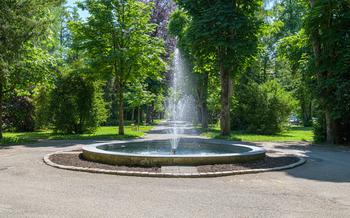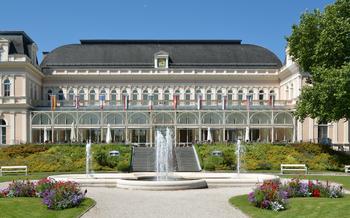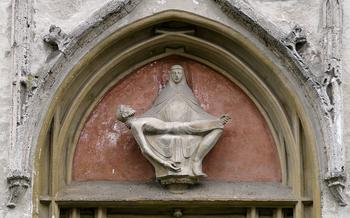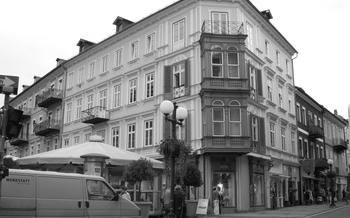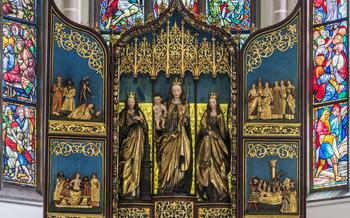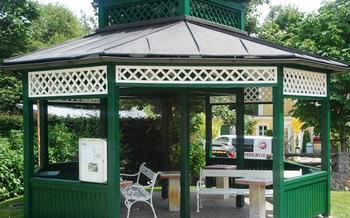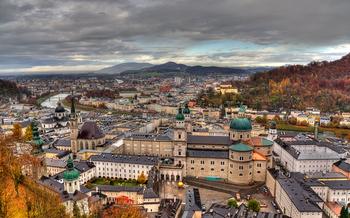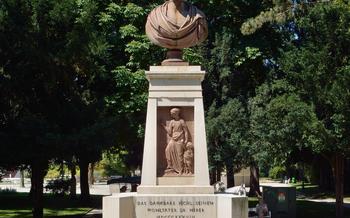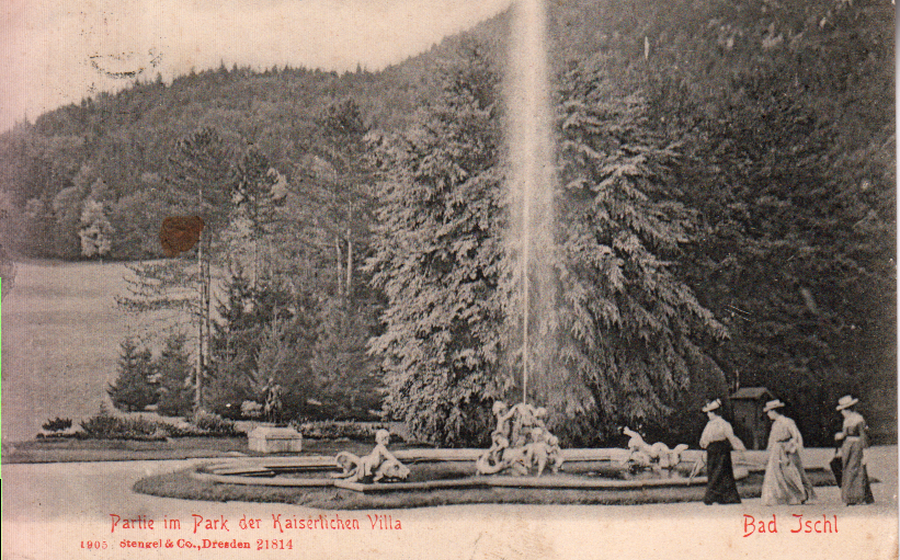
Kaiservilla (Emperor's Villa)
- A Journey to Imperial Splendour
- Exploring the Kaiservilla
- Imperial Gardens and Park
- Imperial Cuisine
- Imperial Spa Town
- Imperial Music and Culture
- Imperial Hunting and Outdoor Pursuits
- Imperial Fashion and Attire
- Imperial Promenades and Leisure
- Imperial Festivities and Celebrations
- Imperial Guests and Diplomacy
- Imperial Legacy and Impact
- Imperial Film and Media
- Imperial Literature and Books
- Insider Tip: Unveiling Hidden Imperial Treasures
A Journey to Imperial Splendour
Bad Ischl, nestled in the picturesque Salzkammergut region of Austria, is a town steeped in imperial history and grandeur. Once a humble village, Bad Ischl's fortunes changed dramatically when Emperor Franz Joseph I and Empress Elisabeth chose it as their summer retreat in the mid-19th century. The imperial couple's love for the town's natural beauty and tranquility transformed it into a thriving imperial summer residence, attracting aristocrats, diplomats, and artists from across the Austro-Hungarian Empire.
The Salzkammergut region, with its pristine lakes, lush forests, and towering mountains, captivated the imperial family. Its idyllic landscapes provided a welcome respite from the rigors of court life in Vienna. Bad Ischl, in particular, enchanted the imperial couple with its charm and tranquility. The town's strategic location, accessible by both road and rail, made it an ideal summer destination.
The imperial family's patronage had a profound impact on Bad Ischl's development. The town underwent a remarkable transformation, becoming a vibrant cultural and social hub. Grand villas and hotels sprang up to accommodate the influx of imperial guests, and the town's infrastructure was modernized to meet the needs of the imperial court.
Reaching Bad Ischl from major cities in Austria is a breeze. From Vienna, the capital of Austria, it's a scenic 3-hour train journey through the picturesque countryside. Alternatively, a comfortable 2-hour drive along the scenic Alpine roads leads to Bad Ischl. The town's proximity to Salzburg, another major Austrian city, makes it easily accessible by a 1-hour train ride or a 45-minute drive.
Exploring the Kaiservilla
The Kaiservilla, a magnificent testament to imperial grandeur, stands as a centerpiece of Bad Ischl's imperial heritage. Its architectural elegance blends Renaissance and Neoclassical styles, creating a harmonious fusion of grandeur and grace. As you step inside, you'll be transported back in time, immersing yourself in the personal lives of Emperor Franz Joseph I and Empress Elisabeth.
Guided tours, available in multiple languages, provide a captivating narrative, delving into the historical significance of each room and sharing anecdotes that bring the imperial era to life. The Emperor's study, with its intricate wooden paneling and stately desk, offers a glimpse into his life of governance and diplomacy. In contrast, the Empress's salon, adorned with elegant furniture and personal touches, reveals her love for art, music, and literature.
Highlights of the villa's interior include the grand ballroom, where lavish parties and celebrations once took place, and the music room, where the imperial family entertained guests with their musical talents. The private apartments, with their cozy sitting rooms and intimate bedrooms, provide a glimpse into the family's private life, revealing their personal tastes and preferences.
Don't miss the opportunity to explore the villa's extensive gardens, designed by renowned landscape architect Franz Antoine. These beautifully manicured grounds, with their colorful flower beds, serene ponds, and majestic trees, offer a tranquil retreat from the hustle and bustle of imperial life.
Imperial Gardens and Park
The Kaiservilla is surrounded by a sprawling park, a masterpiece of landscape architecture designed by Franz Antoine. This idyllic haven invites visitors to immerse themselves in nature's tranquility, echoing the imperial family's love for the outdoors.
Stroll through the Rose Garden, a riot of colors and fragrances, where hundreds of varieties of roses bloom in profusion. Admire the vibrant hues of the Emperor's Garden, where meticulously manicured flower beds create a tapestry of beauty. Find solace in the Empress's Garden, a secluded oasis with a charming pond and towering trees, where Empress Elisabeth sought refuge and inspiration.
Explore the park's natural landscapes, where babbling brooks meander through lush meadows, and ancient trees stand sentinel. Discover hidden grottoes, romantic follies, and picturesque vistas that reveal the imperial family's discerning taste and appreciation for nature's wonders.
Join a guided tour of the park to delve into its fascinating history and design. Learn about the horticultural techniques employed to create this enchanting oasis and the symbolic significance of various plants and landscapes. Immerse yourself in the imperial era as you wander through these serene gardens, once the playground of royalty.
Imperial Cuisine
The Habsburg dynasty was renowned for its love of fine dining and culinary excellence. The imperial kitchen, under the guidance of skilled chefs and maîtres de cuisine, created exquisite dishes that reflected the imperial family's refined tastes and appreciation for culinary artistry.
The imperial menu featured a variety of signature dishes that became synonymous with the Habsburg court. Tafelspitz, a boiled beef dish served with horseradish sauce, was a particular favorite of Emperor Franz Joseph I. Wiener Schnitzel, a thinly pounded and breaded veal cutlet, is another iconic dish that originated in the imperial kitchen.
Visitors to Bad Ischl can experience the culinary legacy of the Habsburg dynasty at traditional restaurants and culinary events that showcase imperial cuisine. The Imperial Café Zauner, a historic establishment dating back to 1832, serves classic imperial dishes such as Tafelspitz and Viennese pastries in an elegant setting. The annual Bad Ischl Food Festival celebrates the region's culinary traditions, offering visitors the chance to sample imperial-inspired dishes and local delicacies.
For those seeking a truly immersive culinary experience, private cooking classes and workshops are available, where participants can learn to prepare imperial dishes using authentic recipes and techniques. These classes provide a unique opportunity to delve into the history and traditions of imperial cuisine and create delicious dishes fit for an emperor.
Imperial Spa Town
Bad Ischl's reputation as an imperial spa town dates back to the 16th century, when the healing properties of its thermal springs were discovered. The town's thermal springs contain a unique blend of minerals and salts, known for their therapeutic effects on a variety of ailments, including rheumatism, arthritis, and respiratory conditions.
In the 19th century, Bad Ischl became a popular summer retreat for the imperial family, who sought relief from the sweltering heat of Vienna and the opportunity to take advantage of the town's renowned spa facilities. The imperial family's patronage transformed Bad Ischl into a fashionable spa destination, attracting a host of wealthy and influential visitors from across Europe.
The heart of Bad Ischl's imperial spa complex is the Kurhaus, a magnificent building constructed in the late 19th century. The Kurhaus houses a variety of spa facilities, including thermal baths, saunas, and treatment rooms, as well as a grand ballroom and a restaurant. The Trinkhalle, another notable building in the spa complex, is a beautiful pavilion where visitors can sample the town's healing spring waters.
Today, Bad Ischl continues to be a popular spa destination, offering a range of modern spa experiences inspired by imperial traditions. Visitors can indulge in rejuvenating treatments, such as thermal baths, massages, and facials, while enjoying the town's elegant imperial atmosphere.
Imperial Music and Culture
During the imperial era, Bad Ischl was a vibrant cultural hub, attracting renowned musicians and artists from across Europe. The imperial family played a significant role in promoting and supporting the arts, and their passion for music left a lasting impact on the town's cultural legacy.
One of the highlights of the imperial cultural scene was the annual "Ischler Konzerte," a series of classical music concerts held in the Kaiservilla and other imperial venues. These concerts featured performances by some of the most celebrated musicians of the time, including Franz Liszt, Johannes Brahms, and Anton Bruckner. The imperial family often attended these concerts, and their presence added to the prestige and glamour of the events.
In addition to music, the imperial family also supported other forms of art, such as theater, painting, and literature. They commissioned works of art from renowned artists, and their patronage helped to establish Bad Ischl as a center of artistic creativity. The town's rich cultural heritage is still evident today, with numerous art galleries, museums, and theaters showcasing the works of local and international artists.
Visitors to Bad Ischl can experience the town's imperial cultural legacy by attending historical concerts and performances held in the Kaiservilla and other imperial venues. These events often feature period costumes, historical instruments, and performances of music from the imperial era. The town also hosts a variety of cultural festivals and events throughout the year, showcasing its rich artistic heritage and providing visitors with a glimpse into the vibrant cultural life of the imperial era.
Imperial Hunting and Outdoor Pursuits
The Habsburg family shared a profound passion for hunting and other outdoor activities, which they often indulged in within the picturesque landscapes of the Salzkammergut. The imperial hunting lodge, Jagdschloss Ischl, stands as a testament to their hunting legacy. This stunning lodge served as a base for the family's hunting expeditions, providing them with luxurious accommodations amidst the breathtaking natural surroundings.
Beyond the lodge, the vast hunting grounds surrounding Bad Ischl offered ample opportunities for the imperial family to pursue their passion for the outdoors. They engaged in hunting, fishing, and a variety of other outdoor pursuits, reveling in the tranquility and beauty of the region.
For those seeking to immerse themselves in the imperial hunting experience, guided hunting and outdoor adventures are available, allowing visitors to retrace the steps of the Habsburgs and experience the thrill of the chase in this historic setting.
Imperial Fashion and Attire
The Habsburg family was renowned for their impeccable fashion sense and exquisite taste in clothing. Their wardrobe reflected the opulence and glamour of the imperial era, setting trends and influencing European fashion for centuries. Empress Elisabeth, in particular, was known for her trendsetting style and her love for extravagant gowns and elaborate hairstyles.
The imperial wardrobe was a treasure trove of luxurious fabrics, intricate embroideries, and exquisite jewelry. Clothing played a significant role in imperial etiquette, with specific dress codes for different occasions. Formal court balls demanded elaborate gowns and uniforms, while more relaxed summer gatherings allowed for lighter attire.
Visitors to Bad Ischl can explore the imperial fashion legacy through exhibitions and displays showcasing authentic garments and accessories. The Sisi Museum in Vienna houses a vast collection of Empress Elisabeth's personal belongings, including her iconic gowns, jewelry, and beauty products.
For a truly immersive experience, visitors can dress up in imperial attire and step back in time. Several costume rental shops in Bad Ischl offer a wide selection of historical costumes, allowing visitors to channel their inner emperor or empress.
Imperial Promenades and Leisure
The imperial family cherished leisurely walks and strolls through Bad Ischl's picturesque landscapes. The Imperial Promenade, a scenic path skirting the Traun River, served as their preferred route, offering breathtaking views of the surrounding mountains and valleys. Along this promenade, the imperial entourage would indulge in leisurely walks, enjoying the fresh air and the tranquility of their summer retreat.
The imperial family also relished other recreational activities during their stay in Bad Ischl. Boating excursions on the serene waters of the Traun River were a favorite pastime, providing a unique perspective of the town and its idyllic surroundings. Carriage rides through the verdant countryside offered a leisurely way to explore the region's natural beauty. Picnics amidst the picturesque landscapes were another beloved tradition, allowing the imperial family to relax and bond in a more informal setting.
Guided walks and themed tours along the Imperial Promenade are available, providing visitors with historical insights and anecdotes about the imperial family's leisurely pursuits. These tours offer a deeper understanding of the imperial lifestyle and the significance of Bad Ischl as a summer residence.
Imperial Festivities and Celebrations
Bad Ischl, during the imperial era, was not only a place of relaxation and leisure but also a vibrant hub of social events and festivities. The imperial family hosted grand balls, concerts, and other social gatherings that attracted the crème de la crème of European society. The Kaiservilla and its sprawling gardens provided a magnificent backdrop for these lavish celebrations.
One of the most notable events was the annual Kaiserfest, held on Emperor Franz Joseph I's birthday. The town would be adorned with imperial flags and decorations, and a grand parade would take place, featuring military regiments, local Vereine (associations), and festive floats. The festivities culminated in a grand ball held in the Kaiservilla, where the imperial family and their guests would dance the night away.
These imperial festivities were not merely social events but also served a diplomatic purpose. Bad Ischl became a neutral ground for international diplomacy, where foreign dignitaries and royalty could meet and negotiate in a relaxed and informal setting. The imperial family's ability to host these events and foster international relations contributed to Austria's standing as a major European power.
Today, Bad Ischl continues to celebrate its imperial heritage through various festivals and events. The annual Kaiserfest, albeit in a more modest form, is still held, offering a glimpse into the town's glorious past. Other events, such as the Bad Ischl Operetta Festival and the Bad Ischl Summer Music Festival, showcase the town's rich cultural heritage and provide visitors with an opportunity to experience the imperial era's elegance and grandeur.
Imperial Guests and Diplomacy
Bad Ischl's imperial allure extended beyond its role as a summer retreat for the Habsburgs. The town also served as a significant diplomatic hub during the imperial era, hosting foreign dignitaries, royalty, and diplomats from across Europe. The Kaiservilla played a central role in these diplomatic endeavors, providing a neutral ground for international negotiations and meetings.
Historical accounts reveal that Bad Ischl witnessed numerous diplomatic events of great importance. In 1871, Emperor Franz Joseph I and Russian Tsar Alexander II held a secret meeting in the Kaiservilla, laying the foundation for the Dual Alliance between Austria-Hungary and Russia. Similarly, in 1879, the famous "Kissinger Diktat" was signed in Bad Ischl, resolving a territorial dispute between Austria-Hungary and Germany.
The imperial family's diplomatic efforts in Bad Ischl were not limited to bilateral meetings. The town also hosted grand receptions and balls, where members of the imperial court mingled with foreign guests and exchanged pleasantries. These events provided opportunities for informal diplomacy and the strengthening of international relations.
The significance of Bad Ischl as a diplomatic hub cannot be overstated. It served as a neutral ground where delicate negotiations could take place away from the pressures of imperial courts. The town's idyllic setting and the Habsburgs' reputation for hospitality created a conducive atmosphere for diplomatic discussions and agreements.
To this day, Bad Ischl continues to embrace its diplomatic heritage. The town regularly hosts international conferences and events, drawing inspiration from its imperial past. These events provide a platform for dialogue, cooperation, and the promotion of international understanding.
Imperial Legacy and Impact
Bad Ischl's imperial legacy has left an enduring mark on the town's identity and cultural heritage. Once a humble village nestled amidst the Salzkammergut's natural splendor, Bad Ischl transformed into a popular tourist destination, inspired by its imperial past. The town's elegant architecture, manicured parks, and cultural attractions all bear witness to the imperial era's grandeur.
Museums and exhibitions in Bad Ischl are dedicated to preserving and promoting the imperial legacy. The Kaiservilla itself serves as a living museum, showcasing the personal belongings and memorabilia of Emperor Franz Joseph I and Empress Elisabeth. The town's museum, the Heimatmuseum Bad Ischl, delves deeper into the region's history and culture, with exhibits on the imperial era playing a prominent role.
Walking through Bad Ischl's streets, visitors can't help but feel the imperial presence. The Imperial Promenade, lined with majestic trees and offering stunning views of the surrounding mountains, was a favorite strolling ground for the imperial family. The Trinkhalle, where the imperial family took their mineral water treatments, has been lovingly restored and now serves as a cultural center.
The imperial legacy continues to inspire modern-day events and festivals in Bad Ischl. The annual Kaisertage festival, held in August, celebrates the town's imperial past with historical reenactments, concerts, and exhibitions. The Bad Ischl Operetta Festival, held in July, pays homage to the imperial era's love for music and theater.
The enduring fascination with the imperial era is evident in Bad Ischl's tourism industry. Visitors from around the world come to experience the town's imperial charm, immersing themselves in the history and culture of a bygone era. Bad Ischl's imperial legacy is not just a relic of the past; it's a living heritage that continues to shape the town's identity and appeal.
Imperial Film and Media
Bad Ischl and the imperial era have been a captivating subject for filmmakers and media creators worldwide. Numerous Austrian and international films, television shows, and documentaries have explored this fascinating period in history. Historical dramas and biopics have brought the lives of Emperor Franz Joseph I and Empress Elisabeth to life on screen, offering viewers a glimpse into their personal and political worlds.
The Kaiservilla itself has served as a backdrop for several imperial-themed productions, adding authenticity and grandeur to the storytelling. These films and shows have captured the essence of the imperial era, showcasing the opulence, intrigue, and social dynamics that defined this period.
In addition to feature films and television series, documentaries have delved deeper into the history and legacy of the imperial era in Bad Ischl. These documentaries provide insightful perspectives on the political, cultural, and social significance of this time, offering viewers a comprehensive understanding of the era's impact on Austria and beyond.
Bad Ischl also hosts film festivals and screenings dedicated to imperial-era films. These events showcase a diverse range of cinematic works, from historical dramas to contemporary interpretations of the imperial past. Film enthusiasts can immerse themselves in the era's rich history and cultural significance through these festivals and screenings.
Whether it's through feature films, television shows, documentaries, or film festivals, the imperial era in Bad Ischl continues to captivate audiences worldwide, offering a compelling blend of history, drama, and intrigue.
Imperial Literature and Books
Bad Ischl and the imperial era have served as a rich source of inspiration for literary works in Austria and beyond. Historical novels, biographies, and memoirs recount the lives of imperial figures, offering insights into their personal struggles, triumphs, and legacies. Works like Stefan Zweig's "Farewell to Empire" and Erica Jong's "Sappho's Leap" vividly portray the grandeur and complexity of the imperial era.
Furthermore, Bad Ischl and the Salzkammergut region have been immortalized in literary works that capture the essence of the imperial era. Authors like Adalbert Stifter and Marie von Ebner-Eschenbach have woven tales set against the backdrop of the region's stunning landscapes, capturing the charm and allure of the imperial summer residence.
Literary events and book festivals in Bad Ischl celebrate the town's rich literary heritage. The Bad Ischl Literature Festival, held annually, brings together renowned authors, scholars, and literary enthusiasts to discuss and explore imperial-era literature and its enduring impact. Bookstores in the town offer a wide selection of imperial-themed books, allowing visitors to delve deeper into the era's history and culture.
Insider Tip: Unveiling Hidden Imperial Treasures
Beyond the well-known imperial attractions, Bad Ischl and the surrounding region offer a treasure trove of hidden gems waiting to be discovered. For a truly immersive experience, venture off the beaten path and explore these lesser-known imperial sites:
-
Imperial Hunting Lodge: Immerse yourself in the hunting traditions of the Habsburgs at the Jagdschloss Ischl, a secluded hunting lodge nestled in the picturesque Salzkammergut mountains.
-
Imperial Chapel: Discover the exquisite Imperial Chapel, a hidden gem located within the Kaiservilla's grounds. Admire its intricate stained-glass windows and ornate interior, reflecting the imperial family's deep religious devotion.
-
Imperial Stables: Step into the world of imperial equestrian pursuits at the Imperial Stables, where the Habsburgs' prized horses were once housed. Marvel at the well-preserved stables and learn about the imperial family's passion for horses.
-
Imperial Bakery: Indulge in imperial culinary delights at the Imperial Bakery, a family-run business that has been baking traditional pastries and cakes since the imperial era. Sample their mouthwatering creations and experience the sweet tastes of imperial times.
-
Imperial Walking Trails: Embark on a journey through history along the Imperial Walking Trails, a network of paths that wind through the forests and meadows once frequented by the imperial family. Discover hidden viewpoints and immerse yourself in the natural beauty of the Salzkammergut.
To delve deeper into the imperial era, connect with local guides and historians who can provide personalized insights and anecdotes. They can unlock the hidden stories behind the imperial sites and offer a unique perspective on Bad Ischl's rich history.
